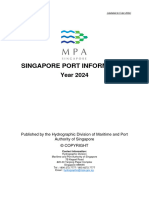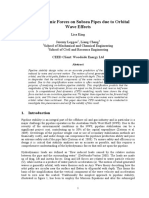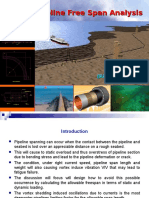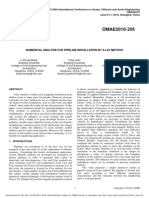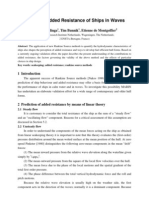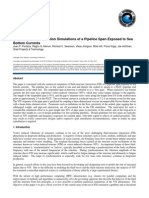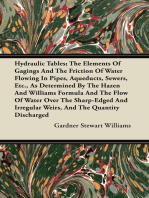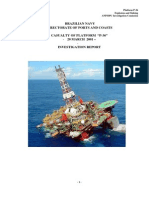0 ratings0% found this document useful (0 votes)
129 viewsA Palmer
A Palmer
Uploaded by
abhi1648665This document summarizes a revised method for analyzing pipeline stability proposed by Veritec based on extensive dynamic analysis. The method uses dimensionless parameters to compare against stability curves, accounting for 3D effects not captured in traditional analysis. It is valid for parameters like Keulegan-Carpenter number from 4-40 and pipe diameter over 0.4m. Outside these ranges, a simplified static analysis is recommended, calibrated using two factors to match the generalized analysis. The analysis allows for some lateral displacement of the pipe.
Copyright:
© All Rights Reserved
Available Formats
Download as TXT, PDF, TXT or read online from Scribd
A Palmer
A Palmer
Uploaded by
abhi16486650 ratings0% found this document useful (0 votes)
129 views10 pagesThis document summarizes a revised method for analyzing pipeline stability proposed by Veritec based on extensive dynamic analysis. The method uses dimensionless parameters to compare against stability curves, accounting for 3D effects not captured in traditional analysis. It is valid for parameters like Keulegan-Carpenter number from 4-40 and pipe diameter over 0.4m. Outside these ranges, a simplified static analysis is recommended, calibrated using two factors to match the generalized analysis. The analysis allows for some lateral displacement of the pipe.
Original Description:
Andrew Palmer
Copyright
© © All Rights Reserved
Available Formats
TXT, PDF, TXT or read online from Scribd
Share this document
Did you find this document useful?
Is this content inappropriate?
This document summarizes a revised method for analyzing pipeline stability proposed by Veritec based on extensive dynamic analysis. The method uses dimensionless parameters to compare against stability curves, accounting for 3D effects not captured in traditional analysis. It is valid for parameters like Keulegan-Carpenter number from 4-40 and pipe diameter over 0.4m. Outside these ranges, a simplified static analysis is recommended, calibrated using two factors to match the generalized analysis. The analysis allows for some lateral displacement of the pipe.
Copyright:
© All Rights Reserved
Available Formats
Download as TXT, PDF, TXT or read online from Scribd
Download as txt, pdf, or txt
0 ratings0% found this document useful (0 votes)
129 views10 pagesA Palmer
A Palmer
Uploaded by
abhi1648665This document summarizes a revised method for analyzing pipeline stability proposed by Veritec based on extensive dynamic analysis. The method uses dimensionless parameters to compare against stability curves, accounting for 3D effects not captured in traditional analysis. It is valid for parameters like Keulegan-Carpenter number from 4-40 and pipe diameter over 0.4m. Outside these ranges, a simplified static analysis is recommended, calibrated using two factors to match the generalized analysis. The analysis allows for some lateral displacement of the pipe.
Copyright:
© All Rights Reserved
Available Formats
Download as TXT, PDF, TXT or read online from Scribd
Download as txt, pdf, or txt
You are on page 1of 10
consistent with the generally accepted model if the degree
of embedment into the bottom is small; but if there is significant embedment, th
e
lateral resistance includes a significant passive-pressure component, generated
by
the weight and internal friction of the sand pushed in front of the pipe.39,40
The Danish Hydraulic Institute carried out tests on sand.41 It investigated
two kinds of loading history, the first with monotonically increasing lateral fo
rce
(representing a slow increase of a steady current across the pipe), and the seco
nd
with an alternating force steadily increasing in magnitude (representing a cycli
c
increase of an alternating force generated by wave-induced currents that corresp
ond
to progressive growth of a storm). Very small movements occur at low values of
S/R, but the pipe does not move far until S/R reaches about 0.5. The movement
then increases rapidly and reaches about half a diameter of the pipeline when S/
R
is 0.7. Embedment into the bottom induces a much higher resistance, even if the
embedment is only a small fraction of a diameter. Cyclic alternation of S leads
the
pipe to settle into the bottom and further increases its resistance to lateral m
ovement
later. The limiting value of S/R (measured when the movement has reached 0.2
diameter) is very much larger than the value observed under monotonically
increasing loading (but otherwise identical test conditions). Generally speaking
,
cyclic loading increases the limiting value of S/R by a factor of about 2.
A pipeline in a trench has much more resistance to movement that a pipeline
on a level seabed. It can become unstable either by sliding up the side of the
trench or by deforming the soil on either side. In the first case, the coefficie
nt f
is increased to f
where
f = tan(a +arctan f ) (11.12)
where
a = side slope of the trench
f is much larger than f. Deformation of the side of a trench by hydrodynamic for
ces
on a pipeline cannot occur unless the soil is very weak.
Stability 383
11.6 Stability Design
The process of stability design brings together the methods of wave and current
prediction, hydrodynamic force calculations from currents, and lateral resistanc
e
analysis. A helpful way of considering the stability of unanchored pipelines is
to
think of the variation in the components R and S of the reaction between the pip
eline
and the seabed, defined in the lateral resistance section. For example, in the c
ase in
which the current is steady and has no oscillatory component (fig. 114a), S is ze
ro
and R is equal to the submerged weight w per unit length in still water. When th
e
current increases, S increases and R falls (because of the hydrodynamic lift). T
he
pipeline becomes unstable at a current corresponding to point Y, and any further
increase in current will sweep the pipeline away. The design problem is to make
w
large enough so that the combination of R and S remains within the stable region
.
A similar diagram can be drawn for unsteady oscillatory flow under waves
(fig. 114b). R and S then change through the wave cycle, and the point that
represents them moves along a curve. In regular waves, the curve will be a close
d
loop. In random waves, it will be an irregular sequence of loops. If the oscilla
tory
currents are small, loop 1, the pipeline will be stable. If the currents are lar
ger, the
pipeline will lose stability. Loop 2 represents a combined wave and current case
in
which the pipeline is just stable.
During the design procedure, the engineer has to confirm that the stability
condition is satisfied. If it is not, weight has to be added to generate more la
teral
resistance. Adding weight externally (e.g., by increasing the thickness of a con
crete
coating) increases the diameter, and the hydrodynamic forces have to be recalcul
ated.
A simple computer program can carry out the design process very rapidly.
It is sometimes argued that it is unnecessarily conservative to design a pipelin
e
to resist the maximum lateral force that can be applied because the maximum
force cannot act simultaneously along the whole length of the line. A limitation
of this argument is that sections of pipe that are less heavily loaded can only
help
to support more heavily loaded sections if shear forces are transmitted along th
e
pipe. Shear forces can only be present if the pipe bends horizontally. Moreover,
there is a possibility of progressive instability, in which the pipe does not mo
ve
384 Subsea Pipeline Engineering
bodily to one side but instead moves in one area at a time. The Danish Hydraulic
Institute, Norwegian Hydrodynamic Laboratory, and American Gas Association
have researched the three-dimensional, time-domain analysis that is required to
take advantage of this effect. They have developed computer models that allow
the progressive motion of a pipeline to be followed in detail. In the present st
ate
of knowledge, it appears to be better practice to design a pipeline to be comple
tely
stable; but programs are available that allow the user to determine the movement
of the pipeline and design it so that the movement does not exceed a maximum
acceptable limit. The results are extremely sensitive to the input assumptions.
Occasionally, it is argued that a pipeline should be designed to resist the
maximum significant wave, rather than the maximum wave. That argument has little
rational basis because if the maximum wave passes across the pipeline, it genera
tes
the corresponding bottom velocities, and the pipeline has to resist the forces t
hey
induce. The fact that the existing sea state can be described by a statistical p
arameter
called the significant wave does not alter this conclusion. However, it is possi
ble to
defend the significant wave method as a crude rough-and-ready way of accounting
for various three-dimensional effects, such as wave directional spectrum spread,
short-crested waves, and the variation of instantaneous force along the length
of the pipeline. At present, there is no simple way of incorporating these effec
ts
in analysis, though it is possible to calculate them by a full three-dimensional
,
finite-element analysis.
Veritec has put forward a revised method of stability analysis based on the
results of an extensive dynamic analysis of various pipelines and has presented
it
through the use of a set of dimensionless parameters. The method is the basis of
a
Norwegian recommended practice, RP E305.42 The dynamic analysis is based on a
time-domain solution of the pipeline stability and incorporates three-dimensiona
l
effects, surface wave spectra, and nonlinear soil resistance.
The generalized stability analysis is performed by comparing known
dimensionless parameters against a set of parametric curves. The procedure
does not give any indication of the physical processes involved or the magnitude
of the hydrodynamic or soil resistance forces. It can be performed blind without
knowledge of the physical procedures being modeled.
Stability 385
The analysis is based on the following dimensionless parameters:
Significant Keulegan-Carpenter number K = UsTu /D
Pipe weight parameter L = Ws /(0.5?wDUs
2)
Current to wave velocity ratio M = Uc /Us
Relative soil weight (sand soil) G = ?s /?w - 1
Shear strength parameter (clay soil) S = Ws /(DSu)
Time parameter T = Tl /Tu
Scaled lateral displacement d = Y/D
where
Us = significant wave-induced seabed velocity
Tu = associated zero-crossing period
Uc = current velocity integrated over the diameter of the pipeline
Dw = mass density of seawater
Ds = mass density of soil
Su = undrained shear strength of clay soil
Tl = duration of the sea state
Y = allowable lateral displacement of the pipe
If no information is available, the allowable displacement in sandy soils is
recommended as 20 m in DNV Zone 1 (more than 500 m away from a platform) or
0 m in DNV Zone 2 (less than 500 m from a platform). In clay soils, no displacem
ent
is allowed. The wave-induced velocity Us and period Tu are determined from a
Jonswap surface wave spectrum. The standard includes a method that allows both
values to be obtained directly from the surface peak period.
The required submerged weight for stability can be determined by
comparing these parameters against dimensionless curves. A safety factor of 1.1
is recommended on the design submerged weight for clay soils.
386 Subsea Pipeline Engineering
The generalized analysis is valid for a certain range of parameters, correspondi
ng
to the range for which the dynamic analysis validation was performed. The
parameters are:
4 < K < 40
0 < M < 0.8
0.7 < G < 1.0 (for sand soil)
0.05 < S < 8.0 (for clay soil)
D > 0.4 m
Outside these ranges, Veritec recommends the simplified static stability
analysis, based on a link between the traditional stability design procedure and
the generalized stability analysis. The results from the two distinct methods ar
e
made consistent with each other through the use of two calibration factors: one
based on the soil conditions, and one based on the Keulegan-Carpenter number
and ratio of wave to current velocity. The calibration factors ensure that the r
esults
of the simplified analysis tie in with the generalized analysis. Each stage in t
he
simplified analysis may not be truly representative of the actual process, but t
he
results are corrected using the two calibration factors. The analysis is again b
ased
on pipelines designed with an allowable lateral displacement of up to 20 m in sa
ndy
soil and 0 m in clay soil.
The water particle velocities are obtained in the same way as in the generalized
analysis. The hydrodynamic forces on the pipeline are obtained from the Morison
equation using coefficients of CD = 0.7, CM = 3.29 and CL = 0.9. (Note that thes
e
values are nominal, as correction is made through the calibration factor.) The
soil resistance is modeled by a linear friction factor. Again, allowance for thi
s
assumption is made through the calibration factor. A safety factor of 1.1 is inc
luded
in the results of the analysis for both clay and sandy soils. Hale has compared
the
designs arrived at with those derived from a parallel program carried out by the
American Gas Association.43,44
RP- E 305 is going to be replaced by a new standard, F 109. A draft was sent
out for industry comment in the summer of 2006, and had substantial changes
from E 305. At the time of this writing (November 2007) the new standard
had not been issued.
Stability 387
11.7 Interaction with
Instability of the Seabed
The traditional stability design methods described above treat the seabed
as stationary and immovable. That assumption is not usually correct under the
extreme wave and current conditions that govern design.45 The seabed too can
begin to move in response to hydrodynamic forces, so that pipeline movement and
active sediment transport occur together.
The stability of a pipeline cannot be considered in isolation from the stability
of
the seabed on which it rests. If the pipeline is unstable, the stability of the
seabed is
likely to be marginal at best. If the seabed is unstable, the pipeline becomes u
nstable
with it. Indeed, a possible interpretation of the success of the traditional app
roach
to design is that it ensures that the pipeline is always heavy enough for the se
abed
to become unstable before the pipeline and that the pipeline then sinks into the
moving seabed material.
If the pipeline is initially partially buried, and a top layer of the seabed beg
ins
to move, then the following three things will occur:
1. The pipeline will be exposed to hydrodynamic forces over a greater fraction
of its diameter.
2. The fluid moving past the line will have a density greater than water
because of the presence of seabed particles.
3. A smaller fraction of the pipeline will be embedded in stationary
material, and the lines resistance to lateral movement will therefore
be much reduced.
All three factors have an adverse effect and undermine (literally!) the validity
of the traditional approach. Palmer and Damgaard examine the issue of seabed
instability in detail. They describe two case studies of pipelines off the coast
of Australia, where the seabed unquestionably becomes grossly unstable long
before the extreme design conditions are reached.46,47 The conventional design
calculations then become irrelevant. They show that seabed mobility in extreme
388 Subsea Pipeline Engineering
conditions is the rule rather than the exception, and that it applies over wide
areas
of the North Sea. Figure 115 shows the wave height at which seabed instability
begins, as a function of particle size, for two water depths.
Fig. 115. Onset of seabed instability
The problem of determining the depth below mud line to which the
seabed becomes mobile is only partly understood. That depth depends on the
Sleath number:
S
U
g s
= 0
1
?
( - )
(11.13)
where
U0 = amplitude of the orbital velocity
? = cyclic wave frequency
g = gravitational acceleration
s = particle specific gravity (referred to seawater)
The depth increases rapidly when S reaches a critical value.48,49,50
Stability 389
The question is complicated by the increases of pore pressure that occurs as
a result of cyclic shear stresses induced by waves. This was the subject of acti
ve
research under the European Union (EU) Liquefaction Around Marine Structures
(LIMAS) program. Within that program, tests on a pipeline resting on a fine-grai
ned
silty soil showed that the soil partially liquefies and that the final level rea
ched by
the pipe depends on its mean specific gravity.51, 52, 53, 54
Neglect of seabed instability is the central flaw in the conventional approach
to stability design, and correcting that flaw is much more important than contin
ued
argument (or continued research) into the Morison equation coefficients or into
more sophisticated hydrodynamic models. Future studies will have to take a more
integrated view of a pipelines interaction with seabed stability and with process
es
like self-burial and scour.
Having said that, the conventional design method does seem in practice
to lead to satisfactory designs, however irrational it may be. There are several
factors that probably make the conventional method conservative, among them
the enhanced lateral resistance produced by embedment, the neglect of wave
long-crestedness and three-dimensional effects generally, and the overestimate o
f
seabed wave-induced velocities produced by idealizing the maximum wave as one
of a series of regular waves all with the same height.
It should not be thought that instability never occurs, but it is invariably
a result of design mistakes (particularly in estimates of maximum waves),
construction mistakes, or loss of weight coating.
390 Subsea Pipeline Engineering
References
1 Komar, P.D. (1976). Beach Processes and Sedimentation. Englewood Cliffs, NJ: P
rentice Hall.
2 Komar, Beach Processes and Sedimentation.
3 Pond, S., and Pickard, G.L. (1989). Introductory Dynamical Oceanography. Oxfor
d: Pergamon.
4 Brown, J., Colling, A., Park, D., Phillips, J., Rothery, D., and Wright, J. (1
989).Waves, Tides and
Shallow-Water Processes. Oxford: Pergamon.
5 Sarpkaya, T., and Isaacson, M. (1981).Mechanics of Wave Forces on Offshore Str
uctures. New
York: Van Nostrand Reinhold.
6 Embrechts, P., Kluppelberg, C., and Mikosch, T. (1997). Modelling Extreme Even
ts. Berlin:
Springer-Verlag.
7 Brink-Kjaer, O., Knudsen, J., Roodenhuis, G.S., and Rugbjerg, M. (1984). Extre
me Wave
Conditions in the Central North Sea. Proceedings of the 16th Annual Offshore Tec
hnology
Conference, Houston, TX, 3, 283293.
8 Komar, Beach Processes and Sedimentation.
9 Holthuijsen, L.H. (2007). Waves in Oceanic and Coastal Waters. Cambridge, UK:
Cambridge
University Press.
10 Sarpkaya and Isaacson, Mechanics of Wave Forces.
11 St. Denis, M. (1969) On Wind-Generated Waves. In: Topics in Ocean Engineering
, Bretschneider,
C.L. (Ed.; pp. 3741). Houston: Gulf.
12 Borgmann, L.E. (1961). The Frequency Distribution of Near Extremes. Journal o
f Geophysical
Research, 66, 32953307.
13 Brown et al., Waves, Tides and Shallow-Water Processes.
14 Sarpkaya and Isaacson, Mechanics of Wave Forces.
15 Pond and Pickard, Introductory Dynamical Oceanography.
16 Sarpkaya and Isaacson, Mechanics of Wave Forces.
17 Sumer, B.M., and Fredse, J. (2002). The Mechanics of Scour in the Marine Envir
onment.
Singapore: World Scientific.
18 Littlejohns, P.S.G. (1974). Current-Induced Forces on Submarine Pipelines, Hy
draulics Research,
Wallingford, UK [Report], INT 138.
19 Ibid.
20 Ibid.
Stability 391
21 Sarpkaya and Isaacson, Mechanics of Wave Forces.
22 Zdravkovich, M.M. (1997). Flow Around Circular Cylinders: A Comprehensive Gui
de Through
Flow Phenomena, Experiments, Applications, Mathematical Models and Computer Simu
lations.
Oxford: Oxford University Press.
23 Bearman, P.W., and Zdravkovich, M.M. (1978). Flow Around a Circular Cylinder
Near a Plane
Boundary. Journal of Fluid Mechanics, 89, 3347.
24 Sarpkaya and Isaacson, Mechanics of Wave Forces.
25 Bryndum, M.B., and Jacobsen, V. (1983). Hydrodynamic Forces from Wave and Cur
rent
Loads on Submarine Pipelines. Proceedings of the 15th Annual Offshore Technology
Conference,
Houston, TX, 1, 95102.
26 Wilkinson, R.H., Palmer, A.C., Ells, J.W., Seymour, E., and Sanderson. N. (19
88). Stability of
Pipelines in Trenches. Proceedings of the Offshore Oil and Gas Pipeline Technolo
gy Seminar,
Stavanger, Norway.
27 Bryndum and Jacobsen, Hydrodynamic Forces.
28 Wolfram, W.R., Getz, J.R., and Verley, R.L.P. (1987). PIPESTAB Project: Impro
ved Design Basis
for Submarine Pipeline Stability. Proceedings of the 19th Annual Offshore Techno
logy Conference,
Houston, TX, 3, 153158.
29 Holte, K., Sotberg, T., and Chao. J.C. (1987). An efficient Computer Model fo
r Predicting
Submarine Pipeline Response to Waves and Currents. Proceedings of the 19th Annua
l Offshore
Technology Conference, Houston, TX, 3, 159169.
30 Verley, R.L.P., and Reed, K. (1987). Prediction of Hydrodynamic Forces on Sea
bed Pipelines.
Proceedings of the 19th Annual Offshore Technology Conference, Houston, TX, 3, 1
59169.
31 Fyfe, A. J., Myrhaug, D., and Reed. K. (1987). Hydrodynamic Forces on Seabed
Pipelines: Large-
Scale Laboratory Experiments. Proceedings of the 19th Annual Offshore Technology
Conference,
Houston, TX, 1, 125134.
32 Wilkinson, R.H., and Palmer, A.C. (1988). Field Measurements of Wave Forces o
n Submarine
Pipelines. Proceedings of the 20th Annual Offshore Technology Conference, Housto
n, TX.
33 Grace, R.A. (1978). Marine Pipeline Systems. Englewood Cliffs, NJ: Prentice H
all.
34 Grace, R.A., Castiel, J., Shak, A.T., and Zee. G.T.Y. (1979) Hawaii Ocean Tes
t Pipe Project: Force
Coefficients. Civil Engineering in the Oceans IV, American Society of Civil Engi
neers, 99110.
35 Grace, R.A., and Nicinski, S.A. (1976). Wave Force Coefficients from Pipeline
Research in the
Ocean. Proceedings of the 8th Annual Offshore Technology Conference, Houston, TX
, OTC 2676.
36 Grace, R.A., J.M. Andres, and E.K.S. Lee. Forces Exerted by Shallow Ocean Wav
es on a Rigid Pipe
Set at an Angle to the Flow. Proceedings of the Institution of Civil Engineers,
83, 4359 (1987).
37 Lyons, C.G. (1973). Soil Resistance to Lateral Sliding of Marine Pipelines. P
roceedings of the 5th
Annual Offshore Technology Conference, Houston, TX, 2, 479484.
392 Subsea Pipeline Engineering
38 Lambrakos, K.F. (1985). Marine Pipeline Soil Friction Coefficients from In-Si
tu Testing. Ocean
Engineering, 12, 131150.
39 Brennoden, H., Sveggen, O., Wager, D.A., and Murff, J.D. (1986). Full-Scale P
ipe-Soil Interaction
Tests. Proceedings of the 18th annual Offshore Technology Conference, OTC 5338,
4, 433440.
40 Wagner, D.A., Murff, J.D., Brennoden, H., and Sveggen, O. (1987). Pipe-Soil I
nteraction Model.
Proceedings of the 19th Annual Offshore Technology Conference, OTC 5504, 3, 18119
0.
41 Palmer, A.C., Steenfelt, J., Steensen-Bach, J.O., and Jacobsen, V. (1988). Pr
oceedings of the 20th
annual Offshore Technology Converence, OTC 5853, 4, 399408.
42 On-Bottom Stability Design of Marine Pipelines. (1988). RP E305, Veritec.<Is
this note complete?>
43 Hale, J.R., Lammert, W.F., and Allen, D.W. (1991). Pipeline On-Bottom Stabili
ty Calculations:
Comparison of Two State-Of-The-Art Methods and Pipe-Soil Model Interaction. Proc
eedings of
the 23rd Annual Offshore Technology Conference, OTC 6761, 4, 567582.
44 Submarine Pipeline On-Bottom Stability: Vol. 1. Analysis and Design Guideline
s, Final Report on
Projects PR-178516 and PR-178717. (1988). American Gas Association.
45 Palmer, A.C. (1996). A Flaw in the Conventional Approach to Stability Design
of Pipelines.
Proceedings of the Offshore Pipeline Technology Conference, Amsterdam.
46 Palmer, A Flaw in the Conventional Approach to Stability Design of Pipelines.
47 Damgaard, J.S., and Palmer, A.C. (2001). Pipeline Stability on a Mobile and L
iquefied Seabed: A
Discussion of Magnitudes and Engineering Implications. Proceedings of the 20th I
nternational
Conference on Offshore Mechanics and Arctic Engineering, Rio de Janeiro.
48 Sleath, J.F.A. (1994). Sediment Transport in Oscillatory Flow. In: Sediment T
ransport
Mechanisms in Coastal Environments and Rivers, Belorgey, M., Rajaona, R.D. , and
Sleath, J.F.A.
(Eds.). Singapore: World Scientific .
49 Sleath, J.F.A. (1998). Depth of Erosion Under Storm Conditions. Proceedings o
f the 26th
Conference on Coastal Engineering, ASCE, New York, 29682979.
50 Zala Flores, N., and Sleath, J.F.A. (1998). The Mobile Layer in Oscillatory S
heet Flow. Journal of
Geophysical Research, 103, 1278312793.
51 Sassa, S., and Sekiguchi. H. (1999). Wave-induced Liquefaction of Beds of San
d in a Centrifuge.
Geotechnique, 49, 621638.
52 Teh, T.C., Palmer, A.C., and. Damgaard, J.S. (2003). Experimental Study of Ma
rine Pipelines on
Unstable and Liquefied Seabed. Coastal Engineering, 50, 117.
53 Teh, T.C., Palmer, A.C., and Bolton, M.D. (2004)Wave-Induced Seabed Liquefact
ion and
the Stability of Marine Pipelines. Proceedings, International Conference on Cycl
ic Behaviour
of Soils and Liquefaction Phenomena, Ruhruniversitt Bochum, Germany, 449453,
A.A. Balkema, Leiden.
54 Palmer, A.C., Teh, T.C., Bolton, M.D., and Damgaard, J. (2004). Stable Pipeli
nes on Unstable
Seabed: Progress Towards a Rational Design Method. Proceedings, Offshore Pipelin
e Technology
Conference, Amsterdam.
12Marine Pipeline
Construction
12.1 Introduction
This chapter examines the principal methods of
construction. Most marine pipelines are constructed by the
lay-barge method described in section 12.2. Many small- and
intermediate-diameter lines are constructed by the reel-ship
method described in section 12.3. Bundles and some other
lines are installed by pull and tow techniques covered in
section 12.4. Many pipelines have to be trenched, particularly
in shallow water, and some are buried: Trenching and burial
are described in section 12.5.
394 Subsea Pipeline Engineering
12.2 Lay-Barge Construction
12.2.1 Introduction
Lay-barge construction is by far the most frequently used technique for marine
pipeline construction. It remains the method of choice for most pipelines. Lay-b
arge
construction is versatile, flexible, and self-contained. Though it may be expens
ive to
mobilize a lay barge to a remote location, once the barge is in place, it can st
art work
and operate as efficiently as anywhere else, with minimal support from the shore
.
The lay-barge method has little competition for installing large-diameter single
lines (though not bundles); and for smaller-diameter lines, it competes aggressi
vely
with the reel and tow techniques.
The lay-barge system can be seen as a natural development from lowering-in
methods of onshore pipeline construction. It was originally developed in shallow
water in the nearshore Gulf of Mexico in the 1940s and 1950s. The first North Se
a
pipelines were laid in the period 1968 to 1975, among them West Sole, Leman,
Forties (the first large-diameter line in more than 100 m), Frigg, Brent, and
Noordgastransport, all constructed by the lay-barge method. By the standards
of today, lay-barge operations were prone to weather downtime and mechanical
breakdown, and productivity was extraordinarily low and costs very high. The fir
st
Forties line, 170-km long, took two lay barges two seasons each in 197374, and ot
her
lines took even more lay-barge effort. In contrast, the second Forties line was
laid by
one barge in 3 months in the summer of 1990. Figure 121 shows the production
rates on that project, and shows that high lay rates were achieved after a short
time
and that there were few interruptions.1 Laying rates of several km/day are nowad
ays
routine. In 2003, for example, the Allseas Solitaire laid 105 km of 22-in. (558.
8-mm)
concrete-coated pipe in just under 18 days, for the BP (British Petroleum) Clair
project in the North Atlantic to the west of the Shetland Islands. The average l
ay
rate was 6.9 km/day, and the peak lay rate 7.8 km in 24 hours.
Marine Pipeline Construction 395
Fig. 121. Lay-barge production. Courtesy of London, C.J.
Figure 122 shows the S-lay version of the lay barge system schematically
and gives some of the terminology. The construction is based on a moored or
dynamically positioned barge, on which the pipeline is built on a ramp. Lengths
of pipe are lined up at the upper end of the ramp and pass through a series of
welding stations as the barge moves forward. A separate welding line on the barg
e
sometimes welds the pipe lengths together in twos (double jointing) before
they join the main line.
Tensioners apply a tension force to the pipe near the stern end of the ramp.
The pipe leaves the barge at the stern, and its configuration immediately beyond
the stern is a convex-upward curved section, called the overbend, within which i
t
is supported on rollers by a stinger structure. The stinger is a substantial str
ucture,
often nearly 100 m long, generally constructed as a single open framework rigidl
y
fixed to the barge, but it sometimes has one or more buoyant segments hinged to
each other and to the barge.
396 Subsea Pipeline Engineering
Fig. 122. S-Lay lay-barge pipelaying schematic (not to scale)
The pipe loses contact with the stinger at the lift-off point just above the
end. It continues downward through the water as a long suspended span, a
concave-upward curve called the sagbend. It reaches the seabed tangentially
at the touchdown point.
The shape taken up by the pipe in the sagbend is primarily controlled by the
interaction between the applied tension and the submerged weight of the pipe,
and to a lesser extent by the flexural rigidity of the pipe. If the applied tens
ion is
increased, the curvature of the pipe in the sagbend decreases, so that the sagbe
nd
becomes longer and flatter, while the touchdown point moves further from the
barge and the liftoff point moves up the stinger. If the applied tension is redu
ced,
the sagbend curvature increases; and if the tension is reduced too far, the bend
ing
curvature may
You might also like
- Singapore Port Information Year 2024Document137 pagesSingapore Port Information Year 2024maytankerlgasphaltNo ratings yet
- SFI GroupTableDocument8 pagesSFI GroupTableAmitabha100% (2)
- Subsea Pipeline StabilityDocument9 pagesSubsea Pipeline StabilityJhy MhaNo ratings yet
- Weight TrainerDocument89 pagesWeight Trainerabhi1648665No ratings yet
- Lisa - KingDocument6 pagesLisa - KingamirNo ratings yet
- Influence of Lay Barge Motion On PipelayDocument10 pagesInfluence of Lay Barge Motion On PipelayEgwuatu UchennaNo ratings yet
- Computers & Fluids: A. Riasi, A. Nourbakhsh, M. RaiseeDocument10 pagesComputers & Fluids: A. Riasi, A. Nourbakhsh, M. RaiseeAli TrikiNo ratings yet
- TankersDocument19 pagesTankersMohamed EssamNo ratings yet
- Ce44 Applied HydraulicsDocument84 pagesCe44 Applied HydraulicsMouna GuruNo ratings yet
- Class 10 Free Span AnalysisDocument37 pagesClass 10 Free Span AnalysisLK AnhDungNo ratings yet
- Vertical Axis Tidal Current Genrator Paper Salter and TaylorDocument19 pagesVertical Axis Tidal Current Genrator Paper Salter and TaylorAmit DhimanNo ratings yet
- Numerical Analysis For Pipeline Installation by S-Lay MethodDocument9 pagesNumerical Analysis For Pipeline Installation by S-Lay MethodGiuseppe PasqualeNo ratings yet
- Class 10 - Free Span AnalysisDocument37 pagesClass 10 - Free Span AnalysisM R Patraputra100% (2)
- 3 s2.0 B9780123868886000146 Main PDFDocument27 pages3 s2.0 B9780123868886000146 Main PDFYRNo ratings yet
- Interactions of Breaking Waves With A Current Over Cut CellsDocument33 pagesInteractions of Breaking Waves With A Current Over Cut CellsaminhamdipourNo ratings yet
- Guided Wave Testing of Water Loaded StructuresDocument5 pagesGuided Wave Testing of Water Loaded StructuresMahade Hasan DipuNo ratings yet
- Hydrodynamic Forces On Subsea Pipelines - KarremanDocument6 pagesHydrodynamic Forces On Subsea Pipelines - KarremanAlberto darianNo ratings yet
- Fluid Transient Flow Concepts: Classification of Flow. DefinitionsDocument35 pagesFluid Transient Flow Concepts: Classification of Flow. DefinitionsKaren Johnson0% (1)
- Steady Flow - Water Surface Profiles: EM 1110-2-1416 15 Oct 93Document27 pagesSteady Flow - Water Surface Profiles: EM 1110-2-1416 15 Oct 93Natasha GybzyNo ratings yet
- FM-06 Final (45-51)Document7 pagesFM-06 Final (45-51)hadiNo ratings yet
- Design and Modeling of SWCSDocument10 pagesDesign and Modeling of SWCSGod is good tubeNo ratings yet
- 2004 Yossef ICHEDocument9 pages2004 Yossef ICHEVirgilio MartínezNo ratings yet
- Influences of Hydraulic Uplift Pressures On Stability of Gravity DamDocument15 pagesInfluences of Hydraulic Uplift Pressures On Stability of Gravity DamLuriezaRicablancaLuspoNo ratings yet
- 2011 Greenship DallingaDocument12 pages2011 Greenship DallingaTuran Buğra TimurogluNo ratings yet
- Greg Melling, Justin Dix, Stephen Turnock, University of Southampton - Gjm1v07@noc - Soton.ac - Uk Richard Whitehouse, HR WallingfordDocument6 pagesGreg Melling, Justin Dix, Stephen Turnock, University of Southampton - Gjm1v07@noc - Soton.ac - Uk Richard Whitehouse, HR WallingfordMahmoud Abd El LateefNo ratings yet
- Numerical Analysis of The Impact Parameters On TheDocument15 pagesNumerical Analysis of The Impact Parameters On TheZiaudeen HamdardNo ratings yet
- Impact of Pipes Networks Simplification On Water Hammer PhenomenonDocument18 pagesImpact of Pipes Networks Simplification On Water Hammer PhenomenonVelpandian ManiNo ratings yet
- GIW Slurry ManualDocument14 pagesGIW Slurry ManualMehrdad AminkazemiNo ratings yet
- Open Channel FlowDocument10 pagesOpen Channel FlowZoroNo ratings yet
- Analytical-Numerical Coupling Analysis of Submarine Pipeline in J-Lay ProblemDocument9 pagesAnalytical-Numerical Coupling Analysis of Submarine Pipeline in J-Lay Problemnicholas_j_vaughanNo ratings yet
- Question One: EZRA AHUMUZA AEBD 2004/HD16/2447UDocument31 pagesQuestion One: EZRA AHUMUZA AEBD 2004/HD16/2447UEzra AhumuzaNo ratings yet
- Analysis of Mean Velocity and Turbulence Measurements With AdcpsDocument15 pagesAnalysis of Mean Velocity and Turbulence Measurements With AdcpsHaryo ArmonoNo ratings yet
- Short AnswerDocument10 pagesShort AnswerNarendra Singh Shekhawat100% (1)
- Lateral BucklingDocument36 pagesLateral Bucklingrsb72No ratings yet
- Flow Modeling Based Wall Element TechniqueDocument8 pagesFlow Modeling Based Wall Element TechniqueAI Coordinator - CSC JournalsNo ratings yet
- Quasi-Two-Dimensional MHD Duct Flow Around A 180-Degree Sharp Bend in A Strong Magnetic FieldDocument4 pagesQuasi-Two-Dimensional MHD Duct Flow Around A 180-Degree Sharp Bend in A Strong Magnetic Fieldkoushikthephoenix1No ratings yet
- Pressure Transient Control I 2005Document16 pagesPressure Transient Control I 2005eng2022810079No ratings yet
- Concrete Mat 7Document14 pagesConcrete Mat 7Gert-Jan RoelevinkNo ratings yet
- Caihe ch1Document30 pagesCaihe ch1dwaraganathan100% (1)
- Dyamic Behavior of The Deepwater Flexible Pipeline During Pipe Laying ProcessDocument18 pagesDyamic Behavior of The Deepwater Flexible Pipeline During Pipe Laying Processtran phamNo ratings yet
- Numerical Study of Cavitation Inception Due To Vortex/Vortex Interaction in A Ducted PropulsorDocument33 pagesNumerical Study of Cavitation Inception Due To Vortex/Vortex Interaction in A Ducted PropulsorncharalaNo ratings yet
- Boundary Layer Analysis With Navier-Stokes Equation in 2D Channel FlowDocument5 pagesBoundary Layer Analysis With Navier-Stokes Equation in 2D Channel FlowDanielle HaysNo ratings yet
- Z Ho2018 PDFDocument10 pagesZ Ho2018 PDFhsNo ratings yet
- Experimental Study On The Stability of Laminar Flow in A Channel With Streamwise and Oblique RibletsDocument10 pagesExperimental Study On The Stability of Laminar Flow in A Channel With Streamwise and Oblique RibletshsNo ratings yet
- Discharge Coefficient For Sharp-Crested Side Weir in Supercritical Flow PDFDocument8 pagesDischarge Coefficient For Sharp-Crested Side Weir in Supercritical Flow PDFNacera BenslimaneNo ratings yet
- Water Hammer Analysis by Characteristic MethodDocument8 pagesWater Hammer Analysis by Characteristic MethodaduladorNo ratings yet
- Script 1D Hydraulic PDFDocument120 pagesScript 1D Hydraulic PDFFejs Za ScribdNo ratings yet
- Specific Energy and Critical FlowDocument6 pagesSpecific Energy and Critical FlowWahyu SanjayaNo ratings yet
- Friction LossDocument10 pagesFriction Lossasfand12345No ratings yet
- OTC 21070 Fluid-Structure Interaction Simulations of A Pipeline Span Exposed To Sea Bottom CurrentsDocument12 pagesOTC 21070 Fluid-Structure Interaction Simulations of A Pipeline Span Exposed To Sea Bottom CurrentsRasheed YusufNo ratings yet
- OTC 19495 Model Tests For Steel Catenary Riser in Marine ClayDocument7 pagesOTC 19495 Model Tests For Steel Catenary Riser in Marine ClayPablo Cesar TrejoNo ratings yet
- Dinamic Force On An Elbow Caused by A Traveling Liquid SlugDocument11 pagesDinamic Force On An Elbow Caused by A Traveling Liquid SlugshaffetiNo ratings yet
- Hydraulic Tables; The Elements Of Gagings And The Friction Of Water Flowing In Pipes, Aqueducts, Sewers, Etc., As Determined By The Hazen And Williams Formula And The Flow Of Water Over The Sharp-Edged And Irregular Weirs, And The Quantity DischargedFrom EverandHydraulic Tables; The Elements Of Gagings And The Friction Of Water Flowing In Pipes, Aqueducts, Sewers, Etc., As Determined By The Hazen And Williams Formula And The Flow Of Water Over The Sharp-Edged And Irregular Weirs, And The Quantity DischargedNo ratings yet
- The Mechanics of Water-Wheels - A Guide to the Physics at Work in Water-Wheels with a Horizontal AxisFrom EverandThe Mechanics of Water-Wheels - A Guide to the Physics at Work in Water-Wheels with a Horizontal AxisNo ratings yet
- Lithospheric DiscontinuitiesFrom EverandLithospheric DiscontinuitiesHuaiyu YuanNo ratings yet
- UofA Application Pack Clinical Elective Students 2017 2018Document10 pagesUofA Application Pack Clinical Elective Students 2017 2018abhi1648665No ratings yet
- Rockdump TableDocument1 pageRockdump Tableabhi1648665No ratings yet
- Tier 2 Sponsorship Process - Flow Chart PDFDocument1 pageTier 2 Sponsorship Process - Flow Chart PDFabhi1648665No ratings yet
- HygtredwsqDocument1 pageHygtredwsqabhi1648665No ratings yet
- British Raj in IndiaDocument45 pagesBritish Raj in Indiaabhi1648665No ratings yet
- Goals: Dietary AnalysisDocument8 pagesGoals: Dietary Analysisabhi1648665No ratings yet
- Pronounciation of SoundsDocument2 pagesPronounciation of Soundsabhi1648665No ratings yet
- Industrialisation Engineer: Back Tell A Technip Colleague About This Job ApplyDocument1 pageIndustrialisation Engineer: Back Tell A Technip Colleague About This Job Applyabhi1648665No ratings yet
- Net Pay Calculator: The "NIC" and "Income Tax" Tabs Are For Calculation Purposes Only - You Do Not Need To Look at These!Document7 pagesNet Pay Calculator: The "NIC" and "Income Tax" Tabs Are For Calculation Purposes Only - You Do Not Need To Look at These!abhi1648665No ratings yet
- 22Cr MDSDocument6 pages22Cr MDSabhi1648665No ratings yet
- Contingency 1 1 STS 1 Transition 0 Lost JointDocument3 pagesContingency 1 1 STS 1 Transition 0 Lost Jointabhi1648665No ratings yet
- Technical Specification-ZTT Subsea CableDocument9 pagesTechnical Specification-ZTT Subsea Cableabhi1648665No ratings yet
- Oss 301 - 2000 10Document60 pagesOss 301 - 2000 10abhi1648665No ratings yet
- Statoil, Lars Magne HaldorsenDocument50 pagesStatoil, Lars Magne Haldorsenabhi1648665No ratings yet
- Pipe Schedule and Thickness PDFDocument2 pagesPipe Schedule and Thickness PDFskychurch100% (1)
- Analysis of Fires and Firefighting Operations On Container Vessels 5e3d66a0382a7-81-95Document15 pagesAnalysis of Fires and Firefighting Operations On Container Vessels 5e3d66a0382a7-81-95alin grecuNo ratings yet
- Manage Dispatch Report LCS 2Document2 pagesManage Dispatch Report LCS 2Khurram ShahzadNo ratings yet
- Vijay Kumar Gupta (OILER)Document1 pageVijay Kumar Gupta (OILER)VIJAY GUPTANo ratings yet
- Mastrep NewReporting System PDFDocument4 pagesMastrep NewReporting System PDFsomayajNo ratings yet
- Review TextDocument4 pagesReview TextadindaNo ratings yet
- CISN 2020 05 Rev 09 Instructions To ROs and Their Surveyorss With AnnexDocument65 pagesCISN 2020 05 Rev 09 Instructions To ROs and Their Surveyorss With AnnexBtwins123No ratings yet
- Standard Oil Co. of New York vs. Lopez CasteloDocument1 pageStandard Oil Co. of New York vs. Lopez CasteloRic Sayson100% (1)
- Sarsen The Voyage Taking Her HomeDocument18 pagesSarsen The Voyage Taking Her Homeapi-389619753No ratings yet
- PNA9 - Weight and Stability - LectureDocument26 pagesPNA9 - Weight and Stability - LectureKenan YILDIRIMÇAKARNo ratings yet
- The Hamburg Rules - Failure or Success-SvprDocument24 pagesThe Hamburg Rules - Failure or Success-SvprSV Pravin RathinamNo ratings yet
- Jaya Pearl Vessels Specs - Upgraded 100 MT Crane - 21 Oct 16Document3 pagesJaya Pearl Vessels Specs - Upgraded 100 MT Crane - 21 Oct 16Mohammed Ahemd Hassan100% (1)
- PLS-127 (Ship Particular Data Form)Document5 pagesPLS-127 (Ship Particular Data Form)Fatimah NurNo ratings yet
- Arigo Vs Swift - SovereigntyDocument1 pageArigo Vs Swift - SovereigntyMichelle DecedaNo ratings yet
- Relative BearingsDocument2 pagesRelative Bearingskhebiloğlu100% (2)
- 42Document15 pages42supriyo1970No ratings yet
- Fast Rescue Boats PDFDocument74 pagesFast Rescue Boats PDFkenanNo ratings yet
- Marine Engineer CVDocument2 pagesMarine Engineer CVAndreea Aprozianu100% (1)
- UK - Doing Business in Indonesia.Document25 pagesUK - Doing Business in Indonesia.Maxime LongjohnNo ratings yet
- Nyp Guidebook EpdDocument228 pagesNyp Guidebook EpdRuben PinheiroNo ratings yet
- Types of Ship - HTMLDocument3 pagesTypes of Ship - HTMLstamatisNo ratings yet
- Marine and Riverine ProjectsDocument12 pagesMarine and Riverine ProjectsNurali MamenNo ratings yet
- P36 IngDocument29 pagesP36 IngES4891100% (1)
- VocabList N1Document184 pagesVocabList N1Ulysses BloomNo ratings yet
- Bal Time 1939Document3 pagesBal Time 1939Aji PrabowoNo ratings yet
- Hydrostatically Balanced LoadingDocument6 pagesHydrostatically Balanced LoadingTermiteEnkayNo ratings yet
- Basic Port Statistics of India 2019-20Document237 pagesBasic Port Statistics of India 2019-20vasam_remanNo ratings yet
- Bill of Lading: International Master Group LLCDocument1 pageBill of Lading: International Master Group LLCGrupo Master Ls Nic0% (1)
- 5.0 Part C - Detailed List of Mooring EquipmentDocument2 pages5.0 Part C - Detailed List of Mooring EquipmentKaustav RoyNo ratings yet
